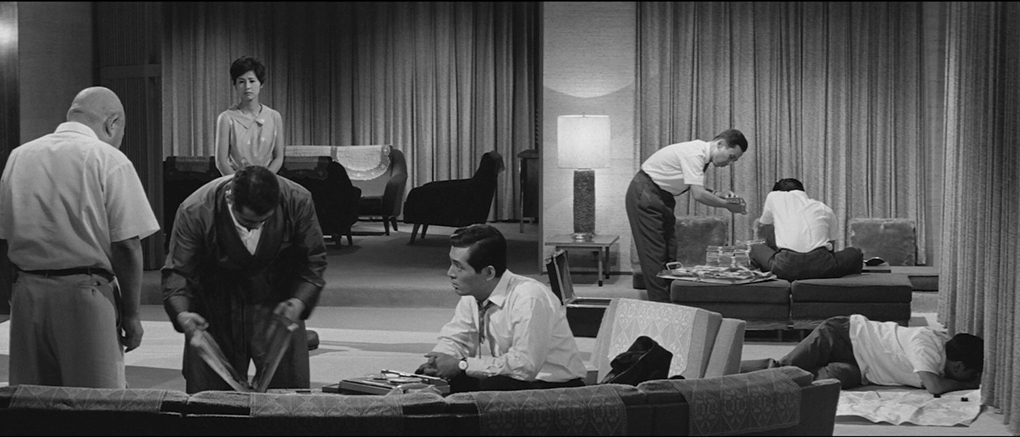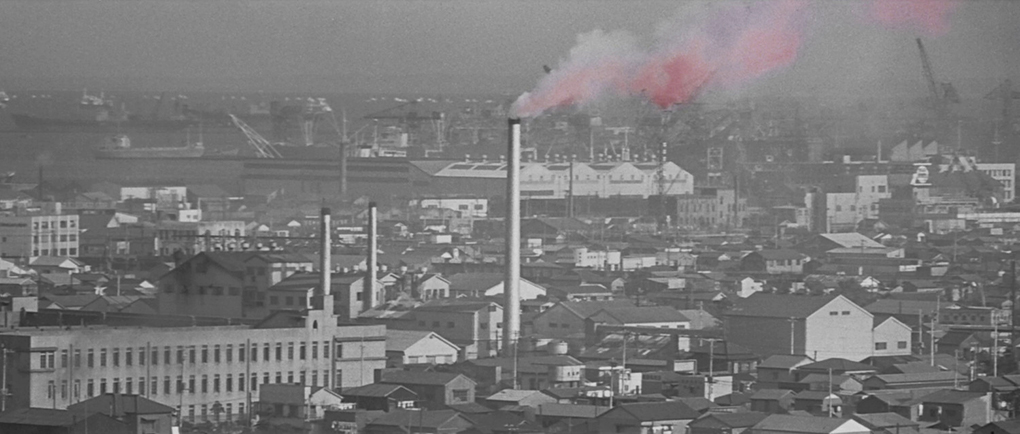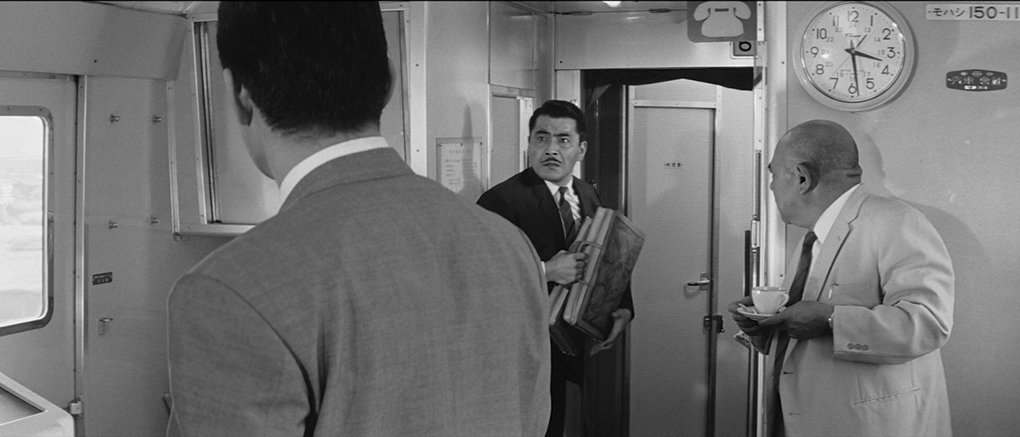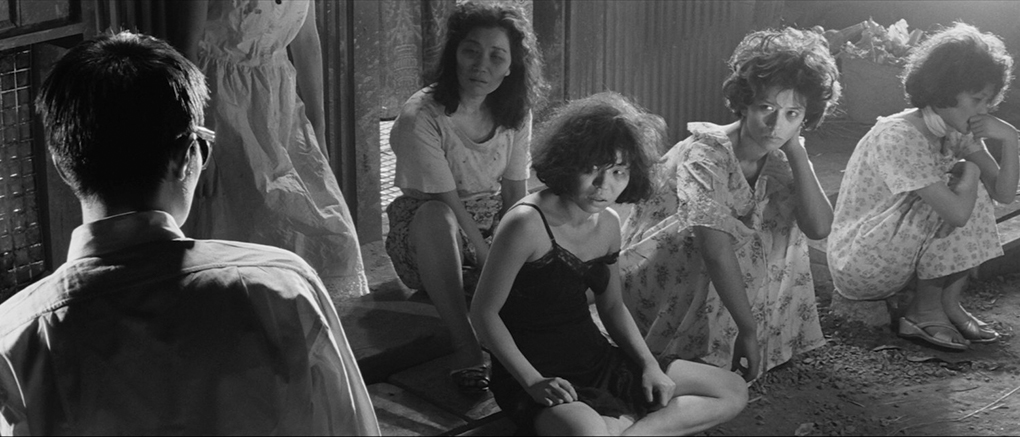|
Kingo Gondo (Toshiro Mifune) is an executive in National Shoes, makers of wear for the higher-class ladies’ feet. He is seeking to buy out the company, to keep its reputation for quality rather than more profitable cheapness. Then he is called by a man who says he has kidnapped Gondo’s son Jun and demands a ransom. However, the kidnapper has mistakenly abducted Shinichi, the son of Gondo’s chauffeur...
This Blu-ray of High and Low (Tengoku to jigoku, literally “Heaven and Hell”, made in 1963) is released by the BFI simultaneously with Kurosawa’s 1949 film Stray Dog. Although the BFI have and will be putting others of his films out on Blu-ray and UHD, this pairing is quite apposite. Both are contemporary-set crime dramas which take some interesting digressions within the genre, and both are set in Japan’s oppressively hot summer. (At one point, the temperature is given as 105ºF, forty degrees for the Celsius-enabled.) Both spend some time in conveying the social conditions of their time. Stray Dog was set in the immediate post-War period, with Japan under US occupation. High and Low shows a country having been rebuilt, a year before it hosted the Olympics. Similarities end though. Stray Dog was an original screenplay, if inspired by a real case. Kurosawa often drew on western sources for his films, basing some on Shakespeare, Dostoevsky and Maxim Gorky. In the case of High and Low, it was the novel King’s Ransom by Ed McBain, a pseudonym of Evan Hunter who wrote non-crime novels under his real name. Kurosawa and his co-writers (Ryūzō Kikushima, Hideo Oguni and Eijiro Hisaita) transplanted the story to contemporary Japan (shot in Yokohama). Something of the original novel is retained in the name of the central character, Kingo Gondo, as McBain’s protagonist is named King.

It may take a little while to realise, but this is a crime thriller where the crime happens offscreen. In fact, after the opening credits just over the first third of the film (some fifty-three minutes) takes place entirely in Gondo’s apartment, mostly in the living room, with just one short scene just outside the front door. The stereophonic sound of a train passing gives us a jolt at the point where we go somewhere else, for a virtuoso five-minute sequence set on a train and shot on a real one. Kurosawa had a liking for narratives broken into unequal parts. Ikiru, for example, has such a narrative break after ninety-two minutes out of 143, and shares a writer, Hideo Oguni, with the present film. High and Low has the same runtime, and here the kidnapping plot is resolved around the hour mark with the rest of the film being a hunt for the kidnapper, with some scenes from his perspective.
Gondo’s apartment, in which so much of the film takes place, was a combination of two studio sets and a real apartment. The latter has a view of Yokohama that shows Kurosawa’s attention to detail: he hired cars to drive over the bridge you can see in the distance so that their headlights show up. The scenes with the curtains drawn were shot in Toho’s studios. Kurosawa shot the scenes in the apartment with multiple cameras, two and sometimes three, on cranes. Needless to say this burned through a lot of film, with the finished scenes edited together from the cameras’ footage. This enabled some lengthy takes, the longest being just under ten minutes, beginning with Gondo, his family and the police listening to a tape recording of a telephone conversation. The sequence on the train was shot with eight cameras in four of the eight carriages, with a ninth camera shooting 8mm footage we see later.
The cinematography of High and Low was the work of two DPs, Asakazu Nakai and Takao Saito, and was shot in Tohoscope. Widescreen arrived in Japan not long after it did in the West, and Kurosawa’s first film in Scope was The Hidden Fortress in 1958. He clearly thrived in the wider format (unlike, say, Ozu, whose films were always “portrait” rather than “landscape” and shot in Academy Ratio until the end of his career) and in High and Low you can see why. Even in interiors such as Gondo’s apartment, he is utilising the entire width of the frame. Kurosawa shot all his films in Scope until Red Beard (1965). High and Low also had a stereo soundtrack, of which more below under “sound and vision”.

108 minutes in, Gondo’s children exclaim that there is pink smoke in the sky. And, for plot reasons, we see it too, in two shots, pink in the otherwise black and white frame. Spot colour was something Kurosawa had wanted to use in Sanjuro but was unsuccessful. This is the first use of colour in any of his films. (On 35mm release prints this short sequence would almost certainly have been printed on colour stock and spliced in at the appropriate place, the rest of the film having been printed on black and white stock.) Otherwise, Kurosawa preferred black and white and continued to make his films that way as long as commercially viable, until Red Beard. If you don’t count his 1970 TV movie Uma no uta (1970) and his uncredited work on Tora! Tora! Tora! (1970 – he left the production after three weeks of shooting), his first all-colour film was Dodes’ka-den, also in 1970. By then, black and white was obsolete, in commercial cinema at least, the few examples still being made exceptions to the colour norm.
High and Low was released in Japan on 1 March 1963 and was a box-office success. The large budgets Kurosawa commanded, and his sometimes protracted shooting schedules, led to conflicts with Toho, and they parted ways after Red Beard, leading to a five-year hiatus in Kurosawa’s cinema career, though they reunited in 1980 with Kagemusha. High and Low had its Western premiere at the 1963 Venice Film Festival on 27 August, when it was in competition. It lost to Francesco Rosi’s Hands Over the City. Released in the USA on 26 November 1963, it was nominated for the Golden Globe for Best Foreign Film, losing to the French film The Big Snatch aka Any Number Can Win (Mélodie en sous-sol). Given what else was up for the award (Tom Jones, The L-Shaped Room, This Sporting Life amongst others), that’s a judgement not endorsed by posterity, and it escaped Oscar attention. High and Low was released in the UK in April 1967, not an especially long gap compared to other Kurosawa films. Stray Dog by contrast didn’t have a British commercial release until 2001. However, that film had been shown on television by then, and High and Low has as I write this never had a broadcast on the small screen in this country.
For a long time, Kurosawa’s contemporary films, with the possible exception of Ikiru, were neglected in favour of his historical ones. Part of this was due to what distributors, in the UK for example, saw Kurosawa as, and picked up his films accordingly. Yet his best contemporary films are among his best films, and High and Low belongs there.
High and Low is released on Blu-ray by the BFI, a disc encoded for Region B only. Back in 1967, the film was cut by the BBFC for an A certificate but now it has a 12.* The BBFC don’t specify the reasons for that, but it’s clearly due to references to drug preparation and use in the final third, particularly to heroin. This includes a shot of a woman being in a state of what is not specified as cold turkey and another of her lying on the floor presumably dead, foam coming out of her mouth and a syringe in her hand.

As mentioned above, the film was shot in 35mm with anamorphic lenses, and this transfer, from a 4K restoration from the original negative, is in the intended ratio of 2.35:1. Comparing this to Stray Dog, a film fourteen years older, is probably unfair as the negative of that no longer exists but that of High and Low does. Also the earlier film would have been shot on nitrate stock, which had been abandoned in the early 1950s in favour of safety stock. With all that said, this is a sharp transfer with strong blacks and whites and greyscale and contrast seem spot-on.
High and Low was released in some cinemas with a stereo soundtrack. Other than earlier experiments such as Disney’s Fantasia, cinema stereo sound came to the fore in the 1950s with releases in 70mm and other large-format processes like Cinerama. 70mm stereo soundtracks were printed on to the film as a magnetic track and were six-track, which was then five front channels and a mono surround. 35mm stereo was also magnetic then, two decades before the arrival of Dolby Stereo on optical tracks, and was four-track (left, centre, right, surround) and some films were bestowed with such soundtracks. This was a premium format for large showcase cinemas in major cities, and everywhere else you would have heard the films in mono. I don’t know which if any cinemas in the UK showing High and Low in 1967 would have played the film in stereo. But here it is on this transfer in two ways, the 4.0 original within a DTS-HD MA 5.1 mix, and a LPCM 2.0 track playing in surround. Other than the 2.0 being mixed louder, there’s not much difference between the two, so the choice is yours. English subtitles are available by default on the feature and the It is Wonderful to Create featurette and are optional. I spotted no errors, though I’m not qualified to comment on the translation from Japanese.
Commentary by Jasper Sharp
The BFI’s Stray Dog release had a half-hour featurette by Jasper Sharp. As he’s on commentary duties here, that explains why there isn’t an equivalent on this disc by him or indeed anyone else. Sharp talks about the history of the Toho studio and Kurosawa’s career there. Sharp quotes Donald Richie a lot, fair enough as Richie was on set when the film was made and wrote about it. Technical aspects are discussed, such as the use of Scope and stereo sound, the multiple cameras on set, and the “broken-backed” structure of the film. High and Low is a lengthy film, but Sharp fills the running time with few dead spots. However, he does go off on some digressions. The scene with the pink smoke segues into a discussion of the pinku eiga genre (basically, soft porn Japanese style) which enables him to get in a namecheck of his own book Behind the Pink Curtain. The relevance of this is that the tiny budgets of pinku eiga films meant they were a lot more profitable than High and Low, despite the latter’s commercial success, but it’s a long way to get to that point. Otherwise this is a well-informed commentary that is definitely worth listening to.
It is Wonderful to Create: High and Low (37:00)
We begin with the man himself, in archive footage, in between puffs on a cigarette: “A truly good movie is really enjoyable. There’s nothing complicated about it. A truly good movie is interesting and easy to understand.” This is another of the featurettes made in 2002, which take a detailed look at one of Kurosawa’s films for half an hour or so, with interviews with many of the still-available cast and crew. It is divided into sections. The first is “Three Gondo Mansions”, detailing the filming of the first third or so of the film, with looks at storyboards to see how the multiple cameras were coordinated. Then we have “The Kotara II Express”, on the making of the train sequence, much shorter on screen than the mansion scenes but given as much attention here. Beers were bought for everyone for the return journey until they realised that one camera hadn’t rolled so some of the scenes would have to be reshot. “Hunting the Kidnapper Like a Dog” deals with the second half of the film, including the spot colour referred to above. Finally, “The Fourth Ending” tells us about two final sequences, one with dialogue and one without, which were scripted, but Kurosawa was never satisfied and these were not included in the finished film. As always, much of this overlaps with material elsewhere on the disc and in the booklet, but in some cases goes into more detail. We also see Kurosawa at work at the editing table.

Booklet
The BFI’s booklet, included with the first pressing of this release only, runs to sixteen pages plus covers. It begins after a spoiler warning with “Double Take” by Alex Barrett. This begins with acknowledging that the film is highly regarded (joint thirteenth-greatest Japanese film of all time, according to a poll in Kinema Junpo magazine) yet much less well known than Kurosawa’s other works, partly due to his being seen as a “westernised” director. High and Low is one of four of his films inflected by film noir, along with Stray Dog, Drunken Angel (1948) and The Bad Sleep Well (1960). Barrett compares the film with the novel (which I haven’t read), pointing out some significant changes other than the shift in location. What they have in common is the attention to detail in the police-procedural aspects. The novel more or less ends at the point where the film has its narrative break mentioned above.
Next is a short piece, “An Anatomy of Heaven and Hell” by Philip Kemp. Its equivalent in the Stray Dog booklet derived from the original 2001 DVD release but there’s no indication that this piece originated then, at least not in the PDF copy I was sent for review. After a cast and crew listing for High and Low, we go back to 1967 and most of David Wilson’s review from the June issue of Monthly Film Bulletin. The booklet also includes notes on the extras and the transfer, and plenty of stills.
As mentioned in the booklet, High and Low is highly regarded but has been rather neglected in comparison to Kurosawa’s historical/samurai films. This disc shows the film as one of Kurosawa’s best, a high bar. No complaints about its presentation on disc, with some useful extras.
|